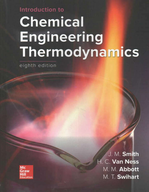Solution Found!
?Gas at constant T and P is contained in a supply line connected through a valve to a
Chapter 3, Problem 3.25(choose chapter or problem)
Gas at constant T and P is contained in a supply line connected through a valve to a closed tank containing the same gas at a lower pressure. The valve is opened to allow flow of gas into the tank, and then is shut again.
(a) Develop a general equation relating \(n_{1}\) and \(n_{2}\), the moles (or mass) of gas in the tank at the beginning and end of the process, to the properties \(U_{1}\) and \(U_{2}\), the internal energy of the gas in the tank at the beginning and end of the process, and H′, the enthalpy of the gas in the supply line, and to Q, the heat transferred to the material in the tank during the process.
(b) Reduce the general equation to its simplest form for the special case of an ideal gas with constant heat capacities.
(c) Further reduce the equation of (b) for the case of \(n_{1}\) = 0.
(d) Further reduce the equation of (c) for the case in which, in addition, Q = 0.
(e) Treating nitrogen as an ideal gas for which \(C_{P} = (7/2)R\), apply the appropriate equation to the case in which a steady supply of nitrogen at 25°C and 3 bar flows into an evacuated tank of \(4 m^{3}\) volume, and calculate the moles of nitrogen that flow into the tank to equalize the pressures for two cases:
1. Assume that no heat flows from the gas to the tank or through the tank walls.
2. Assume that the tank weighs 400 kg, is perfectly insulated, has an initial temperature of 25°C, has a specific heat of \(0.46 kJ \cdot kg^{−1} \cdot K^{−1}\), and is heated by the gas so as always to be at the temperature of the gas in the tank.
Text Transcription:
n_1
n_2
C_p = (7/2)R
4m^3
0.46 kJ dot kg^−1 dot K^−1
Questions & Answers
QUESTION:
Gas at constant T and P is contained in a supply line connected through a valve to a closed tank containing the same gas at a lower pressure. The valve is opened to allow flow of gas into the tank, and then is shut again.
(a) Develop a general equation relating \(n_{1}\) and \(n_{2}\), the moles (or mass) of gas in the tank at the beginning and end of the process, to the properties \(U_{1}\) and \(U_{2}\), the internal energy of the gas in the tank at the beginning and end of the process, and H′, the enthalpy of the gas in the supply line, and to Q, the heat transferred to the material in the tank during the process.
(b) Reduce the general equation to its simplest form for the special case of an ideal gas with constant heat capacities.
(c) Further reduce the equation of (b) for the case of \(n_{1}\) = 0.
(d) Further reduce the equation of (c) for the case in which, in addition, Q = 0.
(e) Treating nitrogen as an ideal gas for which \(C_{P} = (7/2)R\), apply the appropriate equation to the case in which a steady supply of nitrogen at 25°C and 3 bar flows into an evacuated tank of \(4 m^{3}\) volume, and calculate the moles of nitrogen that flow into the tank to equalize the pressures for two cases:
1. Assume that no heat flows from the gas to the tank or through the tank walls.
2. Assume that the tank weighs 400 kg, is perfectly insulated, has an initial temperature of 25°C, has a specific heat of \(0.46 kJ \cdot kg^{−1} \cdot K^{−1}\), and is heated by the gas so as always to be at the temperature of the gas in the tank.
Text Transcription:
n_1
n_2
C_p = (7/2)R
4m^3
0.46 kJ dot kg^−1 dot K^−1
ANSWER:Step 1 of 6
Given
Gas at constant T and P is contained in a supply line connected through a valve to a closed tank containing the same gas at a lower pressure. The valve is opened to allow flow of gas into the tank, and then is shut again.
First we are asked to develop a general equation relating and
, the moles (or mass) of gas in the tank at the beginning and end of the process, to the properties
and
, the internal energy of the gas in the tank at the beginning and end of the process, and
, the enthalpy of the gas in the supply line, and to
, the heat transferred to the material in the tank during the process.
